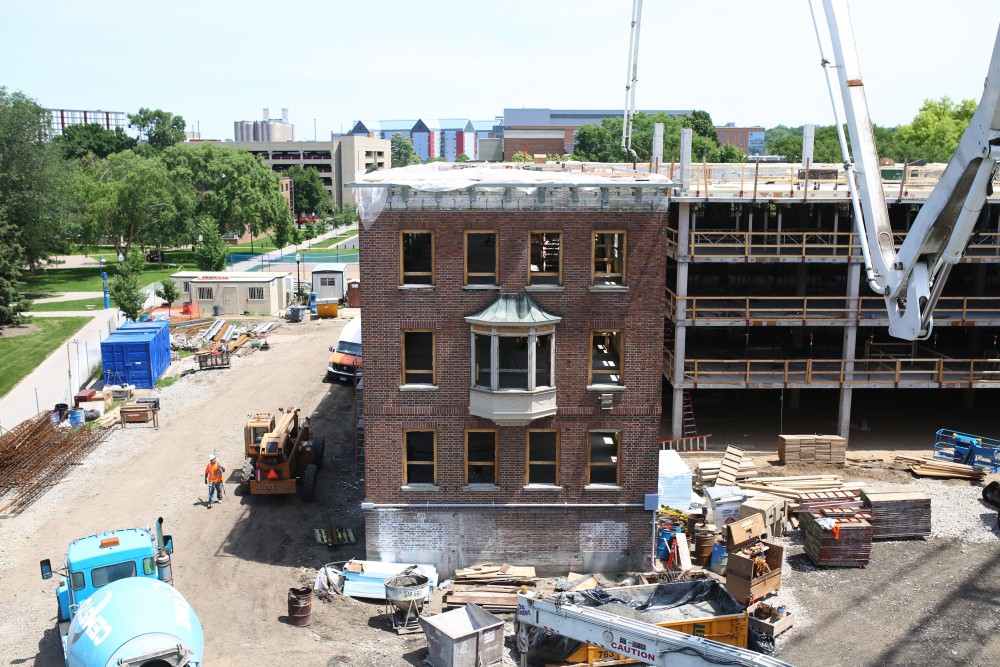Next fall, the newly renovated residence hall will welcome students to live in a new multicultural living-learning community in a building that once contributed to segregation on the University of Minnesota campus.
But what has changed since the hall opened in 1931 highlights what hasn’t.
The ongoing debate over building names and institutional racism at the University has cast fresh eyes on the building’s 88-year-old name. By keeping the name “Pioneer,” some members of the campus community say the residence hall notorious for its ghost stories will remain haunted by an unacknowledged history of land theft and ethnic cleansing.
“Choosing names is a way of marking and sort of memorializing a particular history. But inherent to that, there’s a history of forgetting,” said University history professor William Jones. “[Former president Lotus Coffman] encouraged students to embrace the idea of going into a place and establishing a society. But implicit in that is forgetting that that place was already occupied by Dakota and Ojibwe.”
Jones was a member of the Task Force on Building Names and Institutional History, which created a report that recommended renaming four campus buildings: Coffman Union, Nicholson Hall, Middlebrook Hall and Coffey Hall. In deliberating over the report, Jones said Pioneer was impossible to ignore. Near the end of its 125-page report, the task force calls Pioneer “a case ripe for review.”
“One reason Pioneer Hall was so central to our work is because it was one of the main sites of conflict over the exclusion of Black students from University housing,” the report reads. In 1931, a Black student living in Pioneer Hall was “removed … after a single night.” Another Black student was assigned to Pioneer Hall in 1934 but was turned away before he could move in.
The administration’s plan for the University’s first residence hall was far more ambitious than housing students. Mark Soderstrom, who published his Ph.D. dissertation on segregation at the University in 2004, said the hall was engineered to instill civic values into its white residents.
“These dormitories furnish us with the opportunity of elevating the general tone and social life of the students housed in them,” Coffman wrote in a 1930 letter. “It would be a mistake to assume that the dormitories are merely a place for the students to sleep, eat and work in.”
Pioneers were thought of as virtuous, having brought civilization and Christianity to the frontier. Ironically, Coffman didn’t believe in naming buildings after people. He wanted to give the residents an ideal to aspire to, Jones said.
At Pioneer’s dedication in 1931, Walter Coffey, dean of the Department of Agriculture at the time, said he hopes the students who reside in the hall embrace the “pioneer spirit” of these men. “Within society there are always conditions quite as stubborn as swamp and wilderness which must be conquered if progress is to be made.”
American Indian Student Cultural Center president Summer Lara said the University should consider the history attached to the name.
The Morrill Land Grant Act of 1862 gave Dakota territory to the state to establish the University the same year 38 Dakota were executed in Mankato and hundreds were interned at Fort Snelling.
At the Board of Regents’ March 8 meeting, Regent Richard Beeson said he thinks the University should consider renaming Pioneer and Frontier Hall. “Those names are really inappropriate for today’s world,” he said. “I would hope we could move to look at those buildings almost immediately.”
With the board split on the initial recommendations to rename four buildings, it’s uncertain if the University will examine the names of other buildings.
Robert Cohen, a professor of history and social studies at New York University, said it’s easier to acknowledge racist history when nobody is assigned blame.
“The difference that I see between Pioneer Hall and [the four named buildings] is that these are individuals that did good things for the University and are thought of well,” he said.
















